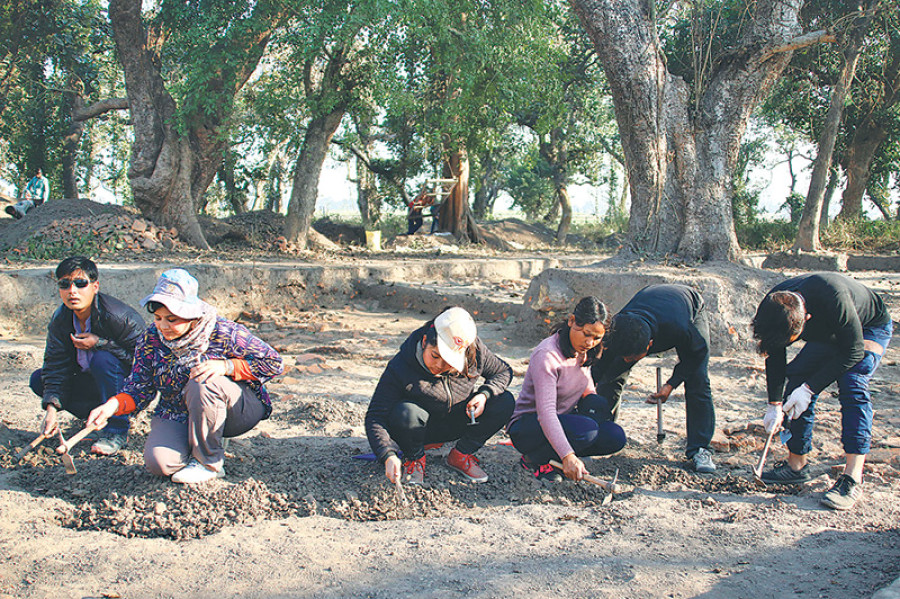Miscellaneous
Under Tilaurakot
At the turn of the fifth century, travelling through South Asia, Chinese monk Faxian had described a flourishing city along what is today the Nepal-India border. Almost two hundred years later, Xuanzang, another Chinese monk and scholar, described seeing a similar flourishing kingdom. Now, an archaeological survey that has been ongoing since 2013 has unearthed evidence suggesting that the sites described by the two ancient travellers match with what has for centuries remained buried underground.
Manoj Paudel
At the turn of the fifth century, travelling through South Asia, Chinese monk Faxian had described a flourishing city along what is today the Nepal-India border. Almost two hundred years later, Xuanzang, another Chinese monk and scholar, described seeing a similar flourishing kingdom.
Now, an archaeological survey that has been ongoing since 2013 has unearthed evidence suggesting that the sites described by the two ancient travellers match with what has for centuries remained buried underground.

These discoveries are not only a cause of celebration for archaeologists alone, but also for tourism entrepreneurs. So much so that when the funds fell short this year, Tokusin Kasai, the chairman of Lumbini Hotel Kasai stepped in to fund Rs 20 million to save the projects from delays and disruptions.

The discovery made in 2015 had already renewed the interest in the lost kingdom, where the Buddha spent the first 29 years of his formative years. A team jointly led by Durham University and the Department of Archaeology (DoA) had already dated the city to have existed since eighth century BC, lending evidence to the claim that the kingdom that Prince Siddhartha (Gautam Buddha) was born into had already been in existence for 300 years prior to his birth. Before this, in 1962, Indian archaeologist Devla Mitra had identified Tilaurakot to be not older than second century BC.

“Now, the discovery of male busts, copper earrings, and other household items which have been dated to be from eighth century BC shows Mitra’s findings to be incomplete,” says Kosh Prasad Acharya, the co-director of the excavation project, “This gives scientific credence to the existence of an age-old civilisation that is at least 2,800 years old. The recent wave of discoveries and scientific dating of the artefacts also shows that Tilaurakot showed first signs of urbanisation starting from sixth century BC.”
Starting mid January this year, using cross disciplinary techniques, a team of archaeologist and students from the Nepal, UK, Pakistan, Bangladesh and Australia excavated three different locations in Tilaurakot until late February. The excavation had used the mapping from a Ground Penetrating Radar (GPR), along with historical archived material to identify the remains of a massive public building that was more than 100 metres in length and breadth. Two years ago, two corners of the structure had already been discovered. This time around, the eastern gateway to the building was also excavated by creating nine 10 X 10 metre trenches in a 30 X 30 metre area. Similarly, the southern gate had been excavated by digging out four 10 X 10 metre trenches in a 10 X 20 metre area.
“It is a great feat that all four doors have now been discovered,” says Ram Bahadur Kunwar, the chief archaeologist of the DoA, “This shows that there was a massive administrative building proving that this ancient civilisation was in fact a complex society.”
Furthermore, the GPR survey also identified a fortified city surrounding the excavated building. Acharya added that roads leading to the eastern and southern gates to the walled-city, and a garrison, most likely used by security personnel, have also been identified. While searching and excavating the entry points to the walled city, it came to the archaeologists’ attention that there were more than four gates to the city of Tilaurakot, but over time, for various reasons, the pathways seemed to have been decommissioned by the rulers. Furthermore, evidence of inner roads, canals, security posts, foundations of other big buildings, and a pond has also been found. “It is not always that an archaeological excavation is this fruitful, but every single site that the two Chinese travellers described have now been identified,” Acharya says, “This is one of the most important archaeological finds in recent Nepali history.”
For more than a month, students and archaeologists were busy cleaning and categorising the recovered artefacts, before they were dated. The watershed findings will inevitably increase the tourist flow in the area, Acharya says. Last year alone, there were 1.55 million tourists visiting Lumbini, according to Lumbini Development Trust. The figures will only continue to rise. Now this raises more questions: How can these new findings be incorporated to enhance the Lumbini experience for religious and non-religious tourists alike? And how can the excavations be better incorporated to narrate the story of the Buddha and the civilisation he was born into.
(All photos by Manoj Poudel)




 16.12°C Kathmandu
16.12°C Kathmandu








%20(1).jpg&w=300&height=200)

